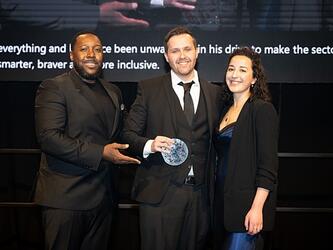Creative treatment
When Macmillan Cancer Support wanted to create new advertising to build both awareness of, and donations for, its work, the creative execution required delicacy and diplomacy that is rarely needed for most brand advertising.
Macmillan had to walk a tightrope between competing needs. The challenge of achieving that balance fell to Carly Wilson, head of integration and brand advertising, and the ad agency VCCP, which she hired to create the campaign.
“To go out there with a piece of advertising, which in one place says, ‘You’re in a really difficult situation and going through one of the toughest things you’ll ever go through – we’re here for you’. And on the other hand, in the same piece of communication, you’ve got to try to say: ‘We can’t be here for everyone right now because we haven’t got enough money so we need your support’; that’s really difficult to do,” says Wilson.
The result was the much-praised ‘Not Alone’ campaign, which launched in February this year and depicted cancer sufferers falling before being caught in someone’s arms. But to get to the truth that formed the kernel of the creative idea required a journey that involved research at every step; from the charity’s earlier brand development work to current agency insight.
Under the skin
Wilson’s brief to VCCP was to develop a campaign that would inspire millions of people to help the charity reach its ambition of improving the lives of everyone with cancer. This meant it had to build brand awareness and drive response. To help with the process, the agency was given a wealth of information including: research; online communities; an online panel Macmillan uses; access to its information centres; shadowing door-to-door fundraisers; and so on.
“They really got under the skin of the organisation and the experience of cancer sufferers,” says Wilson. “The falling idea was a creative concept that VCCP presented to us and it was born out of a huge amount of research they did and came out of a truth that this is how people feel; of not being able to keep up with what people are saying and not taking it all in – essentially that feeling that you’ve been hit by the news and you’re falling,” says Wilson.
No matter what, Wilson was clear that this ad campaign had to be bolder than any of its previous work. “This is a real step change for us and we needed to go out there and be more compelling and braver, and more powerful, in what we do. So we worked closely with the agency, with research groups – all sorts – to make sure we were not overstepping the mark and really upsetting people,” explains Wilson.
Ultimately, was the insight right? Did the campaign strike the right balance? “Personally, I think we’re right on the line,” says Wilson. “I don’t think we should take it any further in terms of how powerful and compelling it is; any more and we’d be in danger of upsetting too many people. We’re here to support everyone and to raise money to increase our charitable expenditure. So, if we upset people, it goes against the very reason we exist. We like to think we’re quite bold and brave as an organisation, and that we’re constantly challenging ourselves, to make sure we’re not being too cautious. I think that’s healthy. To find the right balance, we need to go out and ask people,” she says.
Research will be used to determine the success of the campaign but – so far – it’s too early to glean those metrics. “In terms of recognition, it performed really well. But beyond that, we’re waiting for the next wave of research and tracking,” says Wilson. “We developed a score card for the whole campaign in its broadest sense and that has a number of measures, such as awareness and perception changes, and hard targets too. It’s a challenge, particularly with fundraising. So we test against our banker direct marketing packs and ads – we’ll test certain regions, door to door.”
Cutting through complexity
The ad is the latest manifestation of Macmillan’s positioning, but prior insight was gained from brand development work Macmillan did with Wolff Olins in 2011 to determine where it was as an organisation. It looked at what its positioning was in comparison with others, including Cancer Research and its scientific research, and Marie Curie with its palliative care. Because Macmillan’s remit covers more territory than many cancer charities, its communication job is more complex. This means finding the right language is a particular priority.
“Although we were fairly consistent in most of our communications, there were some inconsistencies. We also needed to review how sensitive we were to being emotive and compelling in our communications,” says Wilson. “The fundraising teams might say we weren’t enough, while other teams might say we were too much.”
For anyone talking about cancer, the use of terms such as ‘battle’ and ‘fight’ divides opinion. “We avoid the battle terminology because it implies you can win or lose, and that’s not fair on people,” says Wilson. “Because if you ‘lose’, does that mean you haven’t tried hard enough?”
“We needed to go out there and be more compelling and braver and more powerful in what we do”
Carly Wilson
While the TV campaign created its own research challenges for Wilson, Macmillan also runs numerous other research projects that are done either as one-offs or as ongoing tracking throughout the organisation. It researches everything from the numbers, needs and experiences of cancer patients and their carers, through to health services. Last year it spent £1.9m on research ( 1.8% of its total charitable spend). Pretty much the only area of research it doesn’t do is medical research.
What its investigations identified are some depressing statistics: in the UK today, two million people are living with a cancer diagnosis and this is set to rise to four million by 2030. Because patients are living longer after their diagnosis than previous generations did, there is an even greater role for a charity geared to helping people live with the disease.
Some of the charity’s most in-depth research has led to a series of ‘Rich Pictures’ of people – segmentations of key groups of cancer patients, drilling down into specific areas according to types of cancer and the ages of those with the disease. Wilson says these add weight to the evidence required during negotiations with partners and health commissioners, and provide evidence to support campaigning activity.
Another important insight it has uncovered is that its donations primarily come from the ‘affected’ group – the 17m people who are family and friends of people who’ve had cancer. “We’ve done a piece of research to look at current supporters and their motivations, so we know that a large number of people support us because they know somebody who’s had a cancer experience,” says Wilson.
“From a marketing perspective, if you’re going to really connect with people, you have to understand the detail. People will donate to charities and causes that are particularly relevant to them, or their situation, or to their local area.
So we can’t be this big, unknown entity that just talks about the big picture stuff all the time. We have to go into the detail,” she adds.
Case study
Macmillan’s World’s Biggest Coffee Morning (WBCM) is now in its 21st year. Since its launch, the event had grown quickly, bringing in millions of pounds. However, growth had slowed in recent years, so Macmillan faced the challenge of finding a way to re-invigorate the event and bring in even more money.
There were two broad strategies the charity could choose: either bring in a new audience for WBCM, or focus on existing supporters and maximise their contributions. To make the right choice, it had to understand the potential value of each audience.
Using supporter data, Macmillan created a detailed analysis of WBCM’s most valuable supporters. These turned out to have a definite ‘type’: women aged 45-65, with above average income, and likely to have had some experience of cancer. Further analysis showed that they were a valuable group who would be very open to supporting Macmillan. Finally, a market sizing exercise showed room for further acquisition within this group.
To compare these results, Macmillan created similar profiles of potential new audiences – older men, younger men and younger women. Macmillan presented focus groups of these audiences with an unbranded description of WBCM. Only the audience of young women showed high levels of interest.
However, when they were told that this would be Macmillan’s WBCM, interest fell. Following the research, it was clear that any attempt to appeal to a new audience by changing the image of WBCM would risk alienating the event’s existing audience. Macmillan, therefore, decided to focus WBCM on its core audience of wealthy, middle-aged women. The decision underpinned its marketing, communications and targeting for the 2012 WBCM. The results were very positive. In 2011 it had raised £10m but in 2012 it raised £15m.
Macmillan’s ambition is to ‘reach and improve the lives of everyone living with cancer and to inspire millions of others to do the same’. This is no mean ambition and it requires a comprehensive level of understanding and insight of that primary audience. “We use research in all kinds of different ways; at a strategic level, market research helps define our corporate strategy. Because of the type of organisation we are, and the environment in which we work, everything we do must be based on hard facts,” explains Wilson.
“We have to work with partners and not just individuals. That involves working with the NHS, government, and so on. In order to get real traction, and to make sure we can put the services in place and we can lobby effectively, we have to have data and insight.”
For ongoing brand health tracking, Macmillan works with The Nursery, running qualitative research up to five times a year. “It starts by looking at awareness and brand knowledge, and then we look into the brand relationship – how people feel about us, compared with our competitors, how close they feel to us. We ask brand attribute questions: likelihood to recommend for health support; likelihood to come to us for support; likelihood to get involved and donate.” The more recent ones have been geared to trying to benchmark the ad campaign.
As its biggest, most integrated campaign to date, Not Alone needs to deliver. “Because we’ve been a brand telling people through our advertising that we’re here for them for a long time, we’ve not done the ‘We need your money now’ appeal before,” says Wilson.
The hope is that the message has come across loud and clear.
- Originally published in Issue 3 of Impact Magazine

We hope you enjoyed this article.
Research Live is published by MRS.
The Market Research Society (MRS) exists to promote and protect the research sector, showcasing how research delivers impact for businesses and government.
Members of MRS enjoy many benefits including tailoured policy guidance, discounts on training and conferences, and access to member-only content.
For example, there's an archive of winning case studies from over a decade of MRS Awards.
Find out more about the benefits of joining MRS here.














0 Comments